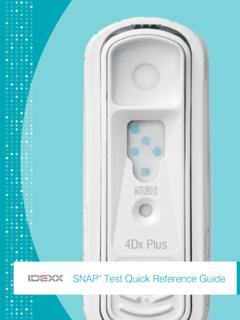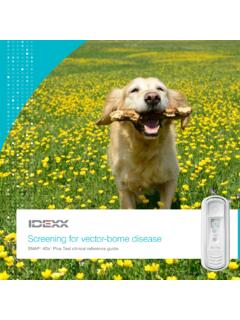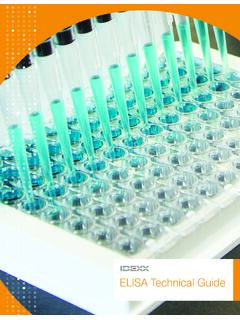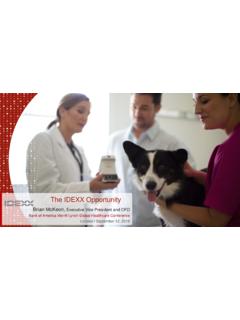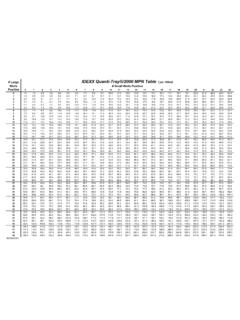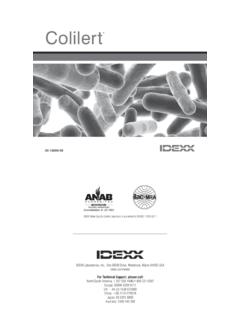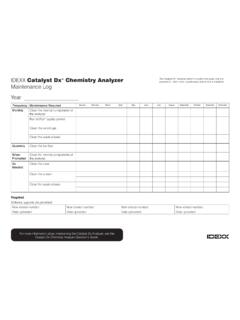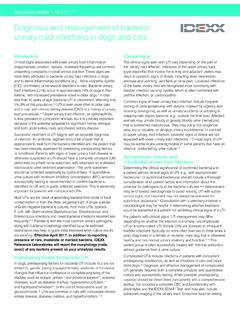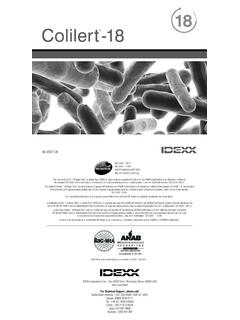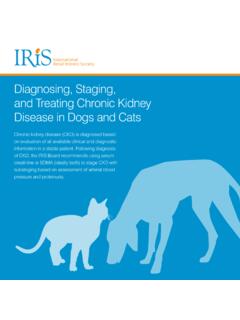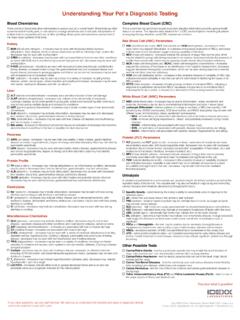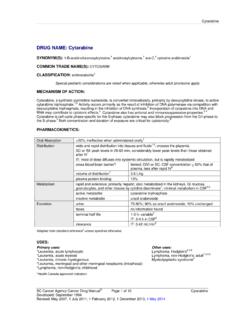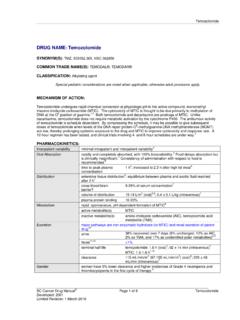Transcription of Diagnosing and Treating Cases of Suspected Canine ...
1 Diagnosing and Treating Cases of Suspected Canine Hyperadrenocorticism or Addison s DiseaseACTH Stimulation TestDiagnostic Protocol for Cases of Suspected Canine Hyperadrenocorticism or Addison s Disease History, physical exam, CBC, chemistry panel, electrolytes and urinalysis consistent with Canine Hyperadrenocorticism or Addison s diseaseDraw 1-hour cortisol (Cortrosyn ) or 1 and 2-hour cortisol (ACTH gel).Perform an ACTH stimulation test with Cortrosyn 5 g/kg IV or ACTH gel U/kg ,Cushing s possibleNormalIf both results are <2 g/dL, results are consistent with hypoadrenocorticismInconclusivePre- and Post-ACTH<2 g/dLPost-ACTH>22 g/dLPost-ACTH2 6 g/dLPre-ACTH: 2 6 g/dLPost-ACTH: 6 18 g/dLPost-ACTH18 22 g/dLDraw baseline cortisol treatment with mineralocorticoid and/or glucocorticoid as Cushing sPerform high-dose dexamethasone * suppression to discriminate between PDH and ATH,ACTH level and/or abdominal ultrasound.
2 * Do not exceed mg/kg of Cortisol Testing GuideIMPORTANT: Review history of any administration of corticosteroids as these may influence the reported , physical exam, CBC, chemistry panel, electrolytes and urinalysis consistent with Canine HyperadrenocorticismDraw 4-hour and 8-hour cortisols; run 8-hour first and 4-hour may not be a low-dose dexamethasone suppression test with mg/kg of dexamethasone baseline cortisol needed> g/dL and>50% of baseline< g/dL or <50% of baseline1 g/dL8 hours4 hours<1 g/dL1 g/dL> g/dL and>50% of baseline> g/dL and >50% of baselineConsistentwith PDH< g/dL or <50% of baseline> g/dL and <50% of baselineConsistentwith PDHC onsistent with Cushing sInconclusive.
3 Consider repeating in 8 12 weeks*Normal> g/dL or >50% of baseline> g/dL and <50% of baselineConsistentwith PDHP erform high-dose dexamethasone ** suppression , endogenous ACTH concentration and/or abdominal ultrasound to discriminate between PDH and ATH.* Wait a minimum of 48 hours before repeating if a technical error in the protocol occurred.** Do not exceed mg/kg of dexamethasone suppression ProtocolFor Cases of Suspected Canine Hyperadrenocorticism DiagnoseHigh-Dose dexamethasone suppression ProtocolFor Determination of Pituitary-Dependent vs. Adrenal Tumor Canine HyperadrenocorticismLow-dose dexamethasone suppression or ACTH stimulation results consistent with Canine HyperadrenocorticismDraw 4-hour a high-dose dexamethasone * suppression test with mg/kg of dexamethasone baseline cortisol with PDHDraw 8-hour cortisol.
4 < g/dL or<50% of baseline< g/dL or<50% of baseline< g/dL or<50% of baseline> g/dL and>50% of baseline> g/dL and>50% of baseline> g/dL and>50% of baseline> g/dL and>50% of baseline8 hours4 hours< g/dL or<50% of baselineFurther testing required to differentiate PDH from ATH. Consider measuring plasma ACTH levels and/or performing an abdominal ultrasound. Diagnose* Do not exceed mg/kg of (Lysodren ) Dosing and MonitoringTreatment of Pituitary Dependent Canine Hyperadrenocorticism * If ACTH stimulation is still >5 g/dL after initial 5 10 days of additional loading, continue loading dose for an additional 5 10 days, observing for adverse mitotane loading dosefor 5 10 days.
5 * Recheck in 5 10 for adverse reactions, as mitotane. Check Na/K to rule out iatrogenic Addison's disease. Supplement with prednisone as needed. Recheck via ACTH stimulation test in 3 4 10 days into loading dose with no adverse effects or clinical response for decrease in appetite,water intake <60 cc/kg/day,vomiting, diarrhea or lethargy. Perform ACTH stimulation ACTH stimulation current weekly weekly dose or repeat loading dose for 5 10 days. Monitor with ACTH stimulation tests and observe for adverse reactions, as above, then increase weekly maintenance the ACTH stimulation test at 3 months and then every 3 6 months thereafter. Use the above response criteria to ensure appropriate mitotane dosing.
6 Should adverse reactions occur at any time during therapy, discontinue mitotane, evaluate patient, perform electrolytes and ACTH stimulation test and treat accordingly. Begin maintenance mitotane dosing: 30 50 mg/kg per week in divided for 1 month unless adverse reactions occur.<1 g/dL1 5 g/dL>5 g/dL<1 g/dL1 5 g/dL>5 g/dLStart loading dose of mitotane therapy: 40 50 mg/kg per day with mitotane. Check Na/K to rule out iatrogenic Addison's disease. Supplement with prednisone as needed. Recheck via ACTH stimulation test in 3 4 weeks. Restart maintenance therapy when appropriate, but at a lower (Vetoryl ) Dosing and Monitoring*Treatment of Canine HyperadrenocorticismDay 1 Start trilostane treatment.
7 Administer 2 mg/kg in morning or 1 mg/kg twice daily with food. Observe for lethargy, decreased appetite, vomiting or diarrhea. If adverse reactions observed discontinue trilostane and evaluate 10 14 Clinical examination and biochemistry profile, including electrolytes. Perform ACTH stimulation test 4 hours after morning at one monthClinical examination and biochemistry profile, including electrolytes. Perform ACTH stimulation test 4 hours serum cortisol > g/dL (>40 nmol/L) and clinically well Continue treatment at current degree of clinical trilostane and evaluate patient. CBC and biochemistry profile, including medical attention may be needed in some dogs.
8 Treat as serum cortisol < g/dL (<40 nmol/L) Stop treatment for 7 at lower TO DAY 1 Clinically wellClinical signs of hypoadrenocorticism*Modified from Treatment and Monitoring of Hyperadrenocorticism flowchart published by Dechra Ltd., 2009. The recommendations contained in this document are intended to provide general guidance only. As with any diagnosis or treatment, you should use clinical discretion with each patient based on a complete evaluation of the patient, including history, physical examination and complete laboratory data profile. With respect to any drug therapy or monitoring program, you should refer to product inserts for a complete description of dosages, indications, interactions and signs not well controlledSignificant improvementStop treatment for 7 days.
9 Restart at lower TO DAY 1 Continue treatment at current on current dose, but monitor clinical signs carefully for morning TO DAY 1 Increase once daily TO DAY 1 Post-ACTH serum cortisol < g/dL (<40 nmol/L) and clinically wellPost-ACTH serum cortisol g/dL (40 165 nmol/L)Post-ACTH serum cortisol g/dL (165 250 nmol/L)Post-ACTH serum cortisol > g/dL (>250 nmol/L)Post-ACTH serum cortisol < g/dL (<165 nmol/L)Post-ACTH serum cortisol > g/dL (>165 nmol/L)Rule out concurrent if twice daily dosing the manufacturer for advice on to monitor per product insert recommendations. Perform ACTH stimulation test 4 hours after morning with ACTH stimulation test (4 hours after morning capsule) and biochemistry profile with electrolytes at 3 months and then every 3 6 months : Should adverse effects occur at any time during therapy, discontinue trilostane and evaluate patient.
10 Perform CBC, biochemistry profile with electrolytes and an ACTH stimulation test and treat accordingly. 2020 IDEXX Laboratories, Inc. All rights reserved. 06-0008966-02 Lysodren is a registered trademark of Bristol-Meyers Squibb Company or one of its divisions or subsidiaries. Cortrosyn is a registered trademark of Amphastar Pharmaceuticals, Inc. Vetoryl is a trademark of Dechra other /TM marks are owned by IDEXX Laboratories, Inc. or its affiliates in the United States and/or other countries. The IDEXX Privacy Policy is available at
